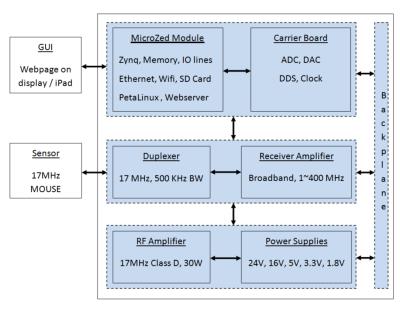4440
A compact handheld MR spectrometer system for mobile MR applications1School of Engineering, Victoria University of Wellington, Wellington, New Zealand, 2School of Chemical and Physical Sciences, Victoria University of Wellington, Wellington, New Zealand
Synopsis
Magnetic Resonance Imaging has established itself as indespensible utility in health sector for over 3 decades, yet remained inflexible in its form factor. By taking advantage of modern advances in miniturisation and improved efficiency of electronic devices along with the developments of single sided magnet probes this abstract presents a handheld, battery powered portable MR spectrometer system which can be used for tissue analysis and sample charectarisation outside of an imaging suite.
Purpose
Develop MR spectrometer console based on modern electronics devices in an attempt to take the MR outside of the imaging suite and enable researchers to explore possible applications of this technology in healthcare and industry.
Introduction
Magnetic Resonance Imaging has established itself as an indespensible utility in health sector for over 3 decades, yet remained inflexible in its form factor. The idea behind mobile MR system is to enable users to bring the system to subject instead of bringing the subject to the system, which yet to be fully realized. By sacrificing high spatial resolution and utilising a light weight single sided magnet design enables us to gain most contrast information such as T1, T2 and self diffusion parameters within the sensitive region of the system1. Thus we have developed a fully integrated mobile MR platform for use with several types of NMR MOUSE sensors such as the Mini-MOUSE2. The mobile platform was made possible by the successful development of compact and efficient Class-D RF power amplifiers combined with a recently released System On a Chip (SoC) device. The SoC device is itself a combination of a high performance dual core ARM processor and Field Programmable Gate Array (FPGA) fabric on a single chip. This allows us to run a linux based operating system, data processing system, pulse sequencer, digital receiver and Tx/Rx control logic. A web based user interfaces is accessible through WiFi connectivity, while a high density LiPo battery pack provides power to the system which can operate for up to 6 hours of continous use on a single charge.Materials and Methods
A prototype system was built using a ZYNQ SoC FPGA module running a Linux OS with a WiFi connection to an iPad running a web based user interface3,4. A 30 W Class-D RF power amplifier and preamp/duplexer was integrated to work with the 17 MHz, Mini-MOUSE sensor. DAC and ADC devices were used to provide the necessary Tx/Rx analogue/digital conversion and a 70 dB gain block was also included to provide the required signal amplification. One key feature of the new platform is that the data from the FPGA based digital receiver is automatically streamed to the main processor system memory via a DMA controller. This allows zero delay between acquisitions and one can also snoop at the data while it is being acquired. The fully integrated system, with rechargeable Lithium batteries to allow six hours of operation, fits in a case measuring 150x120x65 mm and weighs 800 grams, (Figure 1). Experiments showed successful relaxometry measurements on polymer composites and rubber samples (Figure 2).Conclusion
We have successfully demonstrated the development of an ultra compact and portable MR spectrometer console system which is capable of acquiring relaxometry and diffusion information. Experiments have shown successful effective T2 measurements of various samples showing promise for potential use of such a system in healthcare and industrial applications.Acknowledgements
No acknowledgement found.References
1. J. Viess et.al (2016) Monitoring the animals' health status during vivisection by low-field NMR. MRPM 2016 Bologna Italy.
2. D. Oligschlager, et.al (2015), A Miniaturized NMR-MOUSE with a High Magnetic Field Gradient (Mini-MOUSE), Springer, Applied Magnetic Resonance, 181-202, 46
3. www.xilinx.com
4. www.avnet.com
Figures


